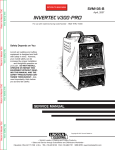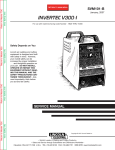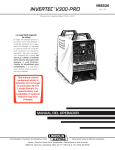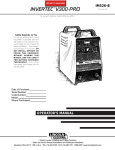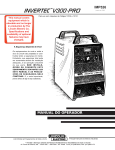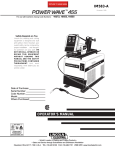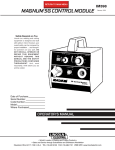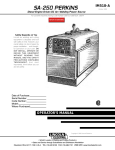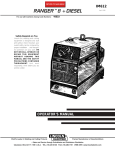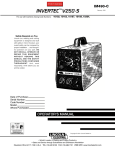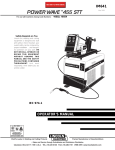Download Lincoln Electric IM465-B Remote Starter User Manual
Transcript
RETURN TO MAIN MENU
INVERTEC DC TIG STARTER
®
IM465-B
October, 1999
This manual for use with DC TIG Starter Codes 9926, 9990 & 10368
Safety Depends on You
Lincoln arc welding and cutting
equipment is designed and built
with safety in mind. However, your
overall safety can be increased by
proper installation ... and thoughtful operation on your part. DO
NOT INSTALL, OPERATE OR
REPAIR THIS EQUIPMENT
WITHOUT READING THIS
MANUAL AND THE SAFETY
PRECAUTIONS CONTAINED
THROUGHOUT. And, most
importantly, think before you act
and be careful.
OPERATOR’S MANUAL
• World's Leader in Welding and Cutting Products •
• Sales and Service through Subsidiaries and Distributors Worldwide •
Cleveland, Ohio 44117-1199 U.S.A. TEL: 216.481.8100 FAX: 216.486.1751 WEB SITE: www.lincolnelectric.com
i
i
SAFETY
WARNING
CALIFORNIA PROPOSITION 65 WARNINGS
Diesel engine exhaust and some of its constituents
are known to the State of California to cause cancer, birth defects, and other reproductive harm.
The Above For Diesel Engines
The engine exhaust from this product contains
chemicals known to the State of California to cause
cancer, birth defects, or other reproductive harm.
The Above For Gasoline Engines
ARC WELDING CAN BE HAZARDOUS. PROTECT YOURSELF AND OTHERS FROM POSSIBLE SERIOUS INJURY OR DEATH.
KEEP CHILDREN AWAY. PACEMAKER WEARERS SHOULD CONSULT WITH THEIR DOCTOR BEFORE OPERATING.
Read and understand the following safety highlights. For additional safety information, it is strongly recommended that you
purchase a copy of “Safety in Welding & Cutting - ANSI Standard Z49.1” from the American Welding Society, P.O. Box
351040, Miami, Florida 33135 or CSA Standard W117.2-1974. A Free copy of “Arc Welding Safety” booklet E205 is available
from the Lincoln Electric Company, 22801 St. Clair Avenue, Cleveland, Ohio 44117-1199.
BE SURE THAT ALL INSTALLATION, OPERATION, MAINTENANCE AND REPAIR PROCEDURES ARE
PERFORMED ONLY BY QUALIFIED INDIVIDUALS.
FOR ENGINE
powered equipment.
1.h. To avoid scalding, do not remove the
radiator pressure cap when the engine is
hot.
1.a. Turn the engine off before troubleshooting and maintenance
work unless the maintenance work requires it to be running.
____________________________________________________
1.b.Operate engines in open, well-ventilated
areas or vent the engine exhaust fumes
outdoors.
____________________________________________________
1.c. Do not add the fuel near an open flame
welding arc or when the engine is running.
Stop the engine and allow it to cool before
refueling to prevent spilled fuel from vaporizing on contact with hot engine parts and
igniting. Do not spill fuel when filling tank. If
fuel is spilled, wipe it up and do not start
engine until fumes have been eliminated.
____________________________________________________
1.d. Keep all equipment safety guards, covers
and devices in position and in good
repair.Keep hands, hair, clothing and tools
away from V-belts, gears, fans and all other
moving parts when starting, operating or
repairing equipment.
____________________________________________________
1.e. In some cases it may be necessary to remove safety
guards to perform required maintenance. Remove
guards only when necessary and replace them when the
maintenance requiring their removal is complete.
Always use the greatest care when working near moving
parts.
___________________________________________________
1.f. Do not put your hands near the engine fan. Do not attempt
to override the governor or idler by pushing on the throttle
control rods while the engine is running.
___________________________________________________
1.g. To prevent accidentally starting gasoline engines while
turning the engine or welding generator during maintenance
work, disconnect the spark plug wires, distributor cap or
magneto wire as appropriate.
ELECTRIC AND
MAGNETIC FIELDS
may be dangerous
2.a. Electric current flowing through any conductor causes
localized Electric and Magnetic Fields (EMF). Welding
current creates EMF fields around welding cables and
welding machines
2.b. EMF fields may interfere with some pacemakers, and
welders having a pacemaker should consult their physician
before welding.
2.c. Exposure to EMF fields in welding may have other health
effects which are now not known.
2.d. All welders should use the following procedures in order to
minimize exposure to EMF fields from the welding circuit:
2.d.1. Route the electrode and work cables together - Secure
them with tape when possible.
2.d.2. Never coil the electrode lead around your body.
2.d.3. Do not place your body between the electrode and
work cables. If the electrode cable is on your right
side, the work cable should also be on your right side.
2.d.4. Connect the work cable to the workpiece as close as
possible to the area being welded.
2.d.5. Do not work next to welding power source.
Mar ‘95
ii
ii
SAFETY
ELECTRIC SHOCK can
kill.
3.a. The electrode and work (or ground) circuits
are electrically “hot” when the welder is on.
Do not touch these “hot” parts with your bare
skin or wet clothing. Wear dry, hole-free
gloves to insulate hands.
3.b. Insulate yourself from work and ground using dry insulation.
Make certain the insulation is large enough to cover your full
area of physical contact with work and ground.
In addition to the normal safety precautions, if welding
must be performed under electrically hazardous
conditions (in damp locations or while wearing wet
clothing; on metal structures such as floors, gratings or
scaffolds; when in cramped positions such as sitting,
kneeling or lying, if there is a high risk of unavoidable or
accidental contact with the workpiece or ground) use
the following equipment:
• Semiautomatic DC Constant Voltage (Wire) Welder.
• DC Manual (Stick) Welder.
• AC Welder with Reduced Voltage Control.
3.c. In semiautomatic or automatic wire welding, the electrode,
electrode reel, welding head, nozzle or semiautomatic
welding gun are also electrically “hot”.
3.d. Always be sure the work cable makes a good electrical
connection with the metal being welded. The connection
should be as close as possible to the area being welded.
3.e. Ground the work or metal to be welded to a good electrical
(earth) ground.
3.f. Maintain the electrode holder, work clamp, welding cable and
welding machine in good, safe operating condition. Replace
damaged insulation.
3.g. Never dip the electrode in water for cooling.
3.h. Never simultaneously touch electrically “hot” parts of
electrode holders connected to two welders because voltage
between the two can be the total of the open circuit voltage
of both welders.
3.i. When working above floor level, use a safety belt to protect
yourself from a fall should you get a shock.
3.j. Also see Items 6.c. and 8.
ARC RAYS can burn.
4.a. Use a shield with the proper filter and cover
plates to protect your eyes from sparks and
the rays of the arc when welding or observing
open arc welding. Headshield and filter lens
should conform to ANSI Z87. I standards.
4.b. Use suitable clothing made from durable flame-resistant
material to protect your skin and that of your helpers from
the arc rays.
4.c. Protect other nearby personnel with suitable, non-flammable
screening and/or warn them not to watch the arc nor expose
themselves to the arc rays or to hot spatter or metal.
FUMES AND GASES
can be dangerous.
5.a. Welding may produce fumes and gases
hazardous to health. Avoid breathing these
fumes and gases.When welding, keep
your head out of the fume. Use enough
ventilation and/or exhaust at the arc to keep
fumes and gases away from the breathing zone. When
welding with electrodes which require special
ventilation such as stainless or hard facing (see
instructions on container or MSDS) or on lead or
cadmium plated steel and other metals or coatings
which produce highly toxic fumes, keep exposure as
low as possible and below Threshold Limit Values (TLV)
using local exhaust or mechanical ventilation. In
confined spaces or in some circumstances, outdoors, a
respirator may be required. Additional precautions are
also required when welding on galvanized steel.
5.b. Do not weld in locations near chlorinated hydrocarbon vapors
coming from degreasing, cleaning or spraying operations.
The heat and rays of the arc can react with solvent vapors to
form phosgene, a highly toxic gas, and other irritating
products.
5.c. Shielding gases used for arc welding can displace air and
cause injury or death. Always use enough ventilation,
especially in confined areas, to insure breathing air is safe.
5.d. Read and understand the manufacturer’s instructions for this
equipment and the consumables to be used, including the
material safety data sheet (MSDS) and follow your
employer’s safety practices. MSDS forms are available from
your welding distributor or from the manufacturer.
5.e. Also see item 1.b.
Mar ‘95
iii
iii
SAFETY
WELDING SPARKS can
cause fire or explosion.
6.a. Remove fire hazards from the welding area.
If this is not possible, cover them to prevent
the welding sparks from starting a fire.
Remember that welding sparks and hot
materials from welding can easily go through small cracks
and openings to adjacent areas. Avoid welding near
hydraulic lines. Have a fire extinguisher readily available.
6.b. Where compressed gases are to be used at the job site,
special precautions should be used to prevent hazardous
situations. Refer to “Safety in Welding and Cutting” (ANSI
Standard Z49.1) and the operating information for the
equipment being used.
6.c. When not welding, make certain no part of the electrode
circuit is touching the work or ground. Accidental contact
can cause overheating and create a fire hazard.
6.d. Do not heat, cut or weld tanks, drums or containers until the
proper steps have been taken to insure that such procedures
will not cause flammable or toxic vapors from substances
inside. They can cause an explosion even though they have
been “cleaned”. For information, purchase “Recommended
Safe Practices for the Preparation for Welding and Cutting of
Containers and Piping That Have Held Hazardous
Substances”, AWS F4.1 from the American Welding Society
(see address above).
6.e. Vent hollow castings or containers before heating, cutting or
welding. They may explode.
6.f. Sparks and spatter are thrown from the welding arc. Wear oil
free protective garments such as leather gloves, heavy shirt,
cuffless trousers, high shoes and a cap over your hair. Wear
ear plugs when welding out of position or in confined places.
Always wear safety glasses with side shields when in a
welding area.
6.g. Connect the work cable to the work as close to the welding
area as practical. Work cables connected to the building
framework or other locations away from the welding area
increase the possibility of the welding current passing
through lifting chains, crane cables or other alternate circuits. This can create fire hazards or overheat lifting chains
or cables until they fail.
6.h. Also see item 1.c.
CYLINDER may explode
if damaged.
7.a. Use only compressed gas cylinders
containing the correct shielding gas for the
process used and properly operating
regulators designed for the gas and
pressure used. All hoses, fittings, etc. should be suitable for
the application and maintained in good condition.
7.b. Always keep cylinders in an upright position securely
chained to an undercarriage or fixed support.
7.c. Cylinders should be located:
• Away from areas where they may be struck or subjected to
physical damage.
• A safe distance from arc welding or cutting operations and
any other source of heat, sparks, or flame.
7.d. Never allow the electrode, electrode holder or any other
electrically “hot” parts to touch a cylinder.
7.e. Keep your head and face away from the cylinder valve outlet
when opening the cylinder valve.
7.f. Valve protection caps should always be in place and hand
tight except when the cylinder is in use or connected for
use.
7.g. Read and follow the instructions on compressed gas
cylinders, associated equipment, and CGA publication P-l,
“Precautions for Safe Handling of Compressed Gases in
Cylinders,” available from the Compressed Gas Association
1235 Jefferson Davis Highway, Arlington, VA 22202.
FOR ELECTRICALLY
powered equipment.
8.a. Turn off input power using the disconnect
switch at the fuse box before working on
the equipment.
8.b. Install equipment in accordance with the U.S. National
Electrical Code, all local codes and the manufacturer’s
recommendations.
8.c. Ground the equipment in accordance with the U.S. National
Electrical Code and the manufacturer’s recommendations.
Mar ‘95
iv
iv
SAFETY
PRÉCAUTIONS DE SÛRETÉ
Pour votre propre protection lire et observer toutes les instructions
et les précautions de sûreté specifiques qui parraissent dans ce
manuel aussi bien que les précautions de sûreté générales suivantes:
Sûreté Pour Soudage A L’Arc
1. Protegez-vous contre la secousse électrique:
a. Les circuits à l’électrode et à la piéce sont sous tension
quand la machine à souder est en marche. Eviter toujours
tout contact entre les parties sous tension et la peau nue
ou les vétements mouillés. Porter des gants secs et sans
trous pour isoler les mains.
b. Faire trés attention de bien s’isoler de la masse quand on
soude dans des endroits humides, ou sur un plancher
metallique ou des grilles metalliques, principalement dans
les positions assis ou couché pour lesquelles une grande
partie du corps peut être en contact avec la masse.
c. Maintenir le porte-électrode, la pince de masse, le câble
de soudage et la machine à souder en bon et sûr état
defonctionnement.
d.Ne jamais plonger le porte-électrode dans l’eau pour le
refroidir.
e. Ne jamais toucher simultanément les parties sous tension
des porte-électrodes connectés à deux machines à souder
parce que la tension entre les deux pinces peut être le
total de la tension à vide des deux machines.
f. Si on utilise la machine à souder comme une source de
courant pour soudage semi-automatique, ces precautions
pour le porte-électrode s’applicuent aussi au pistolet de
soudage.
2. Dans le cas de travail au dessus du niveau du sol, se protéger
contre les chutes dans le cas ou on recoit un choc. Ne jamais
enrouler le câble-électrode autour de n’importe quelle partie
du corps.
3. Un coup d’arc peut être plus sévère qu’un coup de soliel,
donc:
a. Utiliser un bon masque avec un verre filtrant approprié
ainsi qu’un verre blanc afin de se protéger les yeux du rayonnement de l’arc et des projections quand on soude ou
quand on regarde l’arc.
b. Porter des vêtements convenables afin de protéger la
peau de soudeur et des aides contre le rayonnement de
l‘arc.
c. Protéger l’autre personnel travaillant à proximité au
soudage à l’aide d’écrans appropriés et non-inflammables.
4. Des gouttes de laitier en fusion sont émises de l’arc de
soudage. Se protéger avec des vêtements de protection libres
de l’huile, tels que les gants en cuir, chemise épaisse, pantalons sans revers, et chaussures montantes.
5. Toujours porter des lunettes de sécurité dans la zone de
soudage. Utiliser des lunettes avec écrans lateraux dans les
zones où l’on pique le laitier.
6. Eloigner les matériaux inflammables ou les recouvrir afin de
prévenir tout risque d’incendie dû aux étincelles.
7. Quand on ne soude pas, poser la pince à une endroit isolé de
la masse. Un court-circuit accidental peut provoquer un
échauffement et un risque d’incendie.
8. S’assurer que la masse est connectée le plus prés possible
de la zone de travail qu’il est pratique de le faire. Si on place
la masse sur la charpente de la construction ou d’autres
endroits éloignés de la zone de travail, on augmente le risque
de voir passer le courant de soudage par les chaines de levage, câbles de grue, ou autres circuits. Cela peut provoquer
des risques d’incendie ou d’echauffement des chaines et des
câbles jusqu’à ce qu’ils se rompent.
9. Assurer une ventilation suffisante dans la zone de soudage.
Ceci est particuliérement important pour le soudage de tôles
galvanisées plombées, ou cadmiées ou tout autre métal qui
produit des fumeés toxiques.
10. Ne pas souder en présence de vapeurs de chlore provenant
d’opérations de dégraissage, nettoyage ou pistolage. La
chaleur ou les rayons de l’arc peuvent réagir avec les vapeurs
du solvant pour produire du phosgéne (gas fortement toxique)
ou autres produits irritants.
11. Pour obtenir de plus amples renseignements sur la sûreté,
voir le code “Code for safety in welding and cutting” CSA
Standard W 117.2-1974.
PRÉCAUTIONS DE SÛRETÉ POUR
LES MACHINES À SOUDER À
TRANSFORMATEUR ET À
REDRESSEUR
1. Relier à la terre le chassis du poste conformement au code de
l’électricité et aux recommendations du fabricant. Le dispositif
de montage ou la piece à souder doit être branché à une
bonne mise à la terre.
2. Autant que possible, I’installation et l’entretien du poste seront
effectués par un électricien qualifié.
3. Avant de faires des travaux à l’interieur de poste, la debrancher à l’interrupteur à la boite de fusibles.
4. Garder tous les couvercles et dispositifs de sûreté à leur
place.
Mar. ‘93
v
v
Thank You
for selecting a QUALITY product by Lincoln Electric. We want you
to take pride in operating this Lincoln Electric Company product
••• as much pride as we have in bringing this product to you!
Please Examine Carton and Equipment For Damage Immediately
When this equipment is shipped, title passes to the purchaser upon receipt by the carrier. Consequently, Claims
for material damaged in shipment must be made by the purchaser against the transportation company at the
time the shipment is received.
Please record your equipment identification information below for future reference. This information can be
found on your machine nameplate.
Model Name & Number _____________________________________
Code & Serial Number _____________________________________
Date of Purchase
_____________________________________
Whenever you request replacement parts for or information on this equipment always supply the information
you have recorded above.
Read this Operators Manual completely before attempting to use this equipment. Save this manual and keep it
handy for quick reference. Pay particular attention to the safety instructions we have provided for your protection.
The level of seriousness to be applied to each is explained below:
WARNING
This statement appears where the information must be followed exactly to avoid serious personal injury or
loss of life.
CAUTION
This statement appears where the information must be followed to avoid minor personal injury or damage to
this equipment.
vi
TABLE OF CONTENTS
Page
Installation .......................................................................................................Section A
Technical Specifications ........................................................................................A-1
Product Description ...............................................................................................A-2
Recommended Processes and Equipment ...........................................................A-2
Compatible Lincoln Equipment ..............................................................................A-2
Location .................................................................................................................A-2
High Frequency Interference Protection ................................................................A-2
Securing to Invertec...............................................................................................A-3
Input Connection....................................................................................................A-3
Output Connection.................................................................................................A-3
Torch Connection ..................................................................................................A-3
Torch Connection Cover Installation......................................................................A-4
Gas Connection .....................................................................................................A-4
Water/Coolant Return Connection.........................................................................A-4
Water Solenoid Removal .......................................................................................A-4
Coolant Feed Through Connector Installation .......................................................A-4
Operation .........................................................................................................Section B
Safety Precautions ................................................................................................B-1
Limitations..............................................................................................................B-1
Power Source and Starter Kit Operation ...............................................................B-2
Invertec Control Function/Operation......................................................................B-2
DC TIG Starter Control Function/Operation...........................................................B-2
Operation with an Arc Start Switch ........................................................................B-3
Operation with an Amptrol .....................................................................................B-4
Remote Control Switch ..........................................................................................B-4
Accessories .....................................................................................................Section C
Accessories ...........................................................................................................C-1
Maintenance ....................................................................................................Section D
Safety Precautions ................................................................................................D-1
Routine and Periodic Maintenance........................................................................D-1
Troubleshooting ..............................................................................................Section E
Safety Precautions.................................................................................................E-1
How To Use Troubleshooting Guide and General Information..............................E-1
Troubleshooting Guide ..........................................................................................E-2
Environmental Protection.......................................................................................E-6
Printed Circuit Board Replacement .......................................................................E-6
Wiring Diagrams ..............................................................................................Section F
DC TIG Starter Wiring Diagram .............................................................................F-1
Connection Diagram ..............................................................................................F-2
Dimension Print......................................................................................................F-3
DC TIG Starter to Invertec Assembly Illustration ...................................................F-4
Parts Manual ....................................................................................................Appendix
NOTES
A-1
A-1
INSTALLATION
TECHNICAL SPECIFICATIONS – DC TIG STARTER
INPUT
Standard Voltage/Frequency
42 VAC ±15% / 50/60 Hz.
Input Current
2.0 Amps - Rated Output
CURRENT LIMIT
Duty Cycle
60% Duty Cycle
100% Duty Cycle
Amps
300
250
PHYSICAL DIMENSIONS
Height
6.44 in
164 mm
Width
10.72 in
272 mm
Depth
21.01 in
523 mm
INVERTEC DC TIG STARTER
Weight
23 Ibs
10.4 kg
A-2
A-2
INSTALLATION
PRODUCT DESCRIPTION
INSTALLATION
The purpose of the DC TIG Starter is to provide a high
frequency, high voltage pulse for arc starting in DC
TIG welding applications. It is intended to be used
with the Invertec™ power sources which have a 5.5
amp, 42 VAC auxiliary supply. The DC TIG Starter’s
output rating matches the Invertec V300’s (300
amperes DC at a 60% duty cycle and 250 amperes
DC at a 100% duty cycle). The input requirements are
42 VAC, 2.0 amps.
The DC TIG Starter is designed for non-contact starting of DC TIG welding arcs. It can select between 2step and 4-step trigger functioning to control the
Invertec’s energizing of the torch. The DC TIG Starter
has a water solenoid to control the on/off flow of
coolant and a gas solenoid to control a preset preflow
and allow a variable postflow. Maximum current limit
can be adjusted for amptrol™ or arc start switch use.
The DC TIG Starter comes with a preset upslope and
an adjustable downslope. An Amphenol and control
switch are provided for simultaneous wire feeder connection to Invertec power sources.
RECOMMENDED PROCESSES AND
EQUIPMENT
The DC TIG Starter is to be used with DC TIG welding
processes. A work cable, TIG torch, gas supply, and
an arc start switch are required. An optional amptrol
may be used. A water supply is required if using
water- cooled torches.
For best results, use of Thoriated Tungsten electrodes
is recommended.
COMPATIBLE LINCOLN ELECTRIC EQUIPMENT.
WARNING
ELECTRIC SHOCK can kill.
• Have an electrician install and service
this equipment.
• Turn the input power off at the fuse
box before working on equipment.
• Do not touch electrically hot parts.
--------------------------------------------------------------------Location
The DC TIG Starter kit has been designed with many
features to protect it from harsh environments. Even
so, it is important that simple preventative measures
are followed in order to assure long life and reliable
operation.
a. The machine must be located where there is free
circulation of clean air such that air movement in
the back and out the bottom will not be restricted.
Dirt and dust that can be drawn into the machine
should be kept to a minimum.
b. Keep machine dry. Shelter from rain and snow. Do
not place on wet ground or in puddles.
High Frequency Interference Protection
The DC TIG Starter employs a solid state non-contact
torch starting circuit which drastically reduces high frequency emissions from the machine as compared with
spark gap type high frequency generators.
Radiated interference can develop, however, in the
following four ways:
- V300’s with 5.5 amp 42 VAC auxiliary supply.
a. Direct interference radiated from the machine;
- V200’s with 5.5 amp 42 VAC auxiliary supply.
b. Direct interference radiated from the welding leads;
- Field installed options and accessories. See
ACCESSORIES section.
c. Direct interference radiated from feedback into the
power lines;
- Compatible with all Magnum™ one and two piece
water-cooled torches with 7/8 left-hand threads and
gas-cooled torches with 3/8, 5/8, and 7/8 right-hand
threads.
or
- Compatible with Magnum water coolers. The solenoid controlled coolant flow will help yield longer
Magnum cooler life.
d. Interference from reradiation or “pickup” by
ungrounded metallic objects.
Keeping these contributing factors in mind, installing
equipment per the following instructions should minimize problems:
a. Keep the machine power supply lines as short as
possible.
INVERTEC DC TIG STARTER
A-3
A-3
INSTALLATION
b. Keep the work and torch leads as short as possible
and as close together as possible. Lengths should
not exceed 25 ft. (7.6m). Tape the leads together
when practical.
c. Be sure the torch and work cable rubber coverings
are free of cuts and cracks that allow high frequency leakage.
d. Keep the torch in good repair and all connections
tight to reduce high frequency leakage.
NOTE: The DC TIG Starter’s frame is grounded to the
Invertec’s frame by the input cable assembly. The
input cable assembly must be kept in good repair and
all connections kept tight. The Invertec frame must be
grounded per the Invertec’s instruction manual.
e. When the machine is enclosed in a metal building,
several good earth driven electrical grounds around
the periphery of the building are recommended.
f. When the machine is in operation, keep all covers
securely fastened in place to minimize interference
radiation.
Failure to observe these recommended installation
procedures may cause radio or TV interference problems and may result in unsatisfactory performance.
Output Connection
An output cable assembly is supplied with the kit to
connect the DC TIG Starter with the Invertec’s negative or positive output quick connect terminals. (For
electrode negative or positive connections, with the
Invertec mounted on top of the DC TIG Starter). Refer
to S20405 connection diagram at the back of this
manual.
Torch Connection
All Magnum one and two piece gas-cooled or watercooled torches can be connected to the starter kit.
Figure 1 below shows connection of air-cooled torches with the required adapters. One piece torches with
7/8-RH threads do not require an adapter, while one
piece torches with 3/8-RH threads require the 7/8-RH
to 3/8-RH adapter. The use of the 7/8-LH to 1/2” stud
adapter with one piece torches is recommended to
keep debris out of the water connection. Two piece
torches with 5/8-RH threads and a separate electrical
stud connector require the 5/8-RH to 7/8-RH adapter
and the 7/8-LH to 1/2” stud adapter.
FIGURE 1
Connection Diagram for Air-Cooled Torches.
Securing to Invertec
To secure the DC TIG Starter kit to the bottom of the
Invertec, refer to page F-4 at the back of this manual,
and :
a. Remove the bottom 4 wraparound screws from the
Invertec;
b. Place the Invertec on top of and inside the starter
kit’s case;
7/8 - RH POWER / GAS CONNECTION
AIR COOLED TORCH
POWER / GAS
CONNECTION
7/8-RH
DC TIG
STARTER
POWER / WATER
CONNECTION
7/8-LH
-OR-
c. Align holes and reinsert the 4 screws.
-OR-
7/8 - RH TO 3/8 - RH ADAPTER
3/8 - RH POWER /
GAS CONNECTION
AIR COOLED
TORCH
7/8 - LH TO 1/2" STUD ADAPTER
7/8 - RH TO 5/8 - RH ADAPTER
5/8 - RH CONNECTION
POWER / GAS
CONNECTION
7/8-RH
DC TIG
STARTER
Input Connection
An input cable assembly is supplied with the kit to
connect the DC TIG Starter to an Invertec. The cable
makes the connection between the 14-pin Amphenols
on the back of both the DC TIG Starter kit and the
Invertec. Refer to S20405 connection diagram at the
back of this manual.
POWER / WATER
CONNECTION
7/8-LH
INVERTEC DC TIG STARTER
AIR COOLED
TORCH
POWER LUG CONNECTION
7/8 - LH TO 1/2" STUD ADAPTER
A-4
INSTALLATION
Figure 2 below shows connection of water-cooled
torches with the required 7/8-RH to 5/8-RH adapter for
the gas fitting. The water/coolant inlet connection for
the torch should be connected directly to the 7/8-LH
water/coolant connection.
A-4
b. Disconnect all items connected to the DC TIG
Starter from the V300 (input cable, V300 output
cable, torch connection and gas and coolant lines).
c. Uncouple Invertec from DC TIG Starter by removing 4 connecting fasteners.
FIGURE 2
Connection Diagram for Water-Cooled Torches.
d. Detach DC TIG Starter’s wraparound by removing
6 fasteners.
e. Loosen clamp on coolant line then remove line from
solenoid.
f. Remove exterior 5/8-LH connector from solenoid.
POWER / GAS
CONNECTION
7/8-RH
DC TIG
STARTER
POWER / WATER
CONNECTION
7/8-LH
7/8 - RH TO 5/8 - RH ADAPTER
5/8 - RH GAS CONNECTION
g. Disconnect 4 pin mini-molex (P4) from J4 on control board and cut any tie wraps to free the water
solenoid input leads.
WATER-COOLED
TORCH
7/8 - LH POWER / WATER CONNECTION
NOTE: All required adapters are included with the DC
TIG Starter kit.
Torch Connection Cover Installation
A torch connection cover has been provided with the
DC TIG Starter. The cover should be installed using
the 4 screws on the case front.
h. Detach water solenoid from center panel by removing 2 fastening screws.
Coolant Feed Through Connector Installation
a. Insert fitting through vacated hole in case back and
secure with supplied lock washer and hex nut.
Slight clearing of the center panel and case back
may be necessary.
b. Slide coolant hose over fitting and secure with hose
clamp.
Gas Connection
The inlet gas connection is made at the back of the
starter kit.
c. Secure any loose wires by replacing removed tie
wraps.
NOTE: All water/coolant threads are left-hand
threads.
Water/Coolant Return Connection
Solenoid Controlled Water/Coolant Return Connection
The DC TIG Starter is shipped with a solenoid in the
coolant path for fluid control. The water/coolant inlet
connection is made at the 5/8-LH connector at the
back of the DC TIG Starter.
Non-Solenoid Controlled Water/Coolant Return
Connection
Use of water coolers which need non-interrupted fluid
flow require the replacement of the DC TIG Starter’s
water solenoid with the fluid connector supplied with
the kit.
Water Solenoid Removal
a. Turn power off to the V300.
INVERTEC DC TIG STARTER
B-1
B-1
OPERATION
Limitations
OPERATING INSTRUCTIONS
WARNING
ELECTRIC SHOCK can kill.
• Do not touch electrically live parts or
electrode with skin or wet clothing.
• Insulate yourself from work and
ground.
• Always wear dry insulating gloves.
-----------------------------------------------------------------------FUMES AND GASES can be dangerous.
• Keep your head out of fumes.
• Use ventilation or exhaust to remove
fumes from breathing zone.
-----------------------------------------------------------------------WELDING SPARKS can cause fire or
explosion.
• Keep flammable material away.
• Do not weld on closed containers.
-----------------------------------------------------------------------ARC RAYS can burn eyes and skin.
• Wear eye, ear and body
protection.
a. The DC TIG Starter is not recommended for
processes where procedures are not within its current and/or duty cycle ratings.
b. The DC TIG Starter is not intended for use with AC
welding.
c. The DC TIG Starter is not intended for use where
the input voltage will vary more than 15% from 42
VAC.
d. The DC TIG Starter is not intended for use where
the open circuit voltage of the power source is less
than 35 volts or greater than 90 volts.
Additional Safety Precautions
WARNING
HIGH FREQUENCY SHOCK can cause injury or fall.
• Keep the torch and cables in good condition.
• Secure yourself in position to avoid a fall.
• Do not operate machine if it is wet or sitting in
water.
---------------------------------------------------------------------
-----------------------------------------------------------See additional warning information at
front of this operator’s manual.
-----------------------------------------------------------
INVERTEC DC TIG STARTER
B-2
B-2
OPERATION
Power Source and Starter Kit Operation
Duty Cycle
Mode: This switch on the Invertec should be set to the
GTAW position for both scratch start and non-contact,
high frequency starting use.
The DC TIG Starter kit is rated to match the V300
Invertec’s duty cycle of 300 amps, 60% duty cycle,
and 250 amps, 100% duty cycle.
SMAW
CRISP
FCAW
Invertec Control Function/Operation
SMAW
SOFT
GMAW
Power Switch: Placing the Invertec’s power switch in
the “ON” position will energize the Invertec and the
DC TIG Starter kit. When the power is on, the digital
meter in the Invertec will activate and the fans in the
Invertec and the DC TIG Starter kit will operate.
OFF
GTAW
Output Terminals Switch: To allow the DC TIG Starter
kit to control the Invertec’s power to the welding terminals, set this switch on the Invertec to the “REMOTE”
position. Set this switch to the “ON” position for a continuously energized torch.
ON
OUTPUT
TERMINALS
Output Control: The welding current level is set by
adjusting this knob on the Invertec if the Local/Remote
Control Switch is set to the “Local” position. If the
Local/Remote Control Switch is set to the “REMOTE”
position, output current is set by use of optional
remote controls and/or current limit control.
REMOTE
NOTE: The digital meter in the Invertec will indicate
the current limit level when no current is flowing.
When current is flowing, the digital meter will display
the output current level.
Meter Polarity Switch: Located at the rear of the
Invertec, this switch must be placed in the negative
(“-”) position for electrode negative welding and in the
positive (“+”) for electrode positive welding.
OUTPUT
Arc Force/Inductance: This control on the Invertec is
disabled in the GTAW mode.
Has no effect when DC TIG Starter is used.
INVERTEC DC TIG STARTER
B-3
B-3
OPERATION
DC TIG Starter Front Panel
DC TIG Starter Control Function/Operation
Postflow Time: An infinite range of postflow times
between 5 and 55 seconds can be set by adjusting
this knob on the front panel.
Trigger Function Switch: This switch selects a 2-step
or 4-step trigger function when used with an arc start
switch. This switch should be placed in the 2-step
position when the DC TIG Starter is used with an
amptrol. For best utility, the output terminals switch on
the Invertec should be placed in the “REMOTE” position.
Downslope: Current downslope “fade-out” can be regulated from fast (0 seconds) to slow (30 seconds) by
adjusting this knob on the front panel. The current
downslope starts at the level set by the current limit
“CL” knob and reduces to a crater fill level of 25% of
CL. This switch should be placed in the fast (downslope off) position when the DC TIG Starter is used
with an amptrol.
Remote Current Limit: This feature limits the maximum current obtainable when the DC TIG Starter is
used with a remote amptrol or sets the welding current
when the DC TIG Starter is used with an arc start
switch. Current limit can be controlled by adjusting this
knob on the front panel.
Operation with an Arc Start Switch
2-STEP: In this mode, closing the trigger (or arc start
switch) will start the welding process with a 0.5 second gas preflow. The Invertec’s welding terminals will
energize and the solid state starting circuit is enabled.
The starting circuit will continue operation until the arc
has been established or 2 minutes elapse. Once the
welding arc is established, an optimized upslope takes
the welding current up to the desired current limit and
the arc will be maintained as long as the trigger is
closed. Releasing the trigger initiates the
downslope/crater fill sequence and then starts the
postflow timing. Reclosing the trigger during the
downslope/crater fill sequence begins the upslope
sequence starting at the current level reached in the
downslope sequence. Reclosing the trigger during
postflow skips the preflow stage and immediately
restrikes the arc. If the arc is lost during welding, the
starting circuit will resume operation for up to two minutes to re-establish the arc. If the arc is not re-established, the DC TIG Starter kit will shut off the starting
circuit, shut off the Invertec’s trigger, begin postflow
timing, and await the release of the arc start switch.
See FIGURE 3.
INVERTEC DC TIG STARTER
B-4
B-4
OPERATION
FIGURE 3
Operation with an Amptrol
2-Step Trigger Control Using Arc Start Switch
For best use of the DC TIG Starter with an optional
hand or foot amptrol, the Trigger Function Switch
should be placed in the 2-step position and the
downslope control should be placed in the FAST (or
OFF) position.
$
#
!
%%!
$
!
"
Remote Control Switch
%%$%%
"
%%%
#
%%$%&
4-STEP: In this mode, closing the trigger (or arc start
switch) will start the welding process with a 0.5 second
gas preflow. The Invertec’s welding terminals will energize and the solid state starting circuit will operate until
the trigger is opened regardless if the arc has been
established or not. When the welding arc is initiated and
the trigger is released, the optimized upslope will ramp
the current up to the desired current limit. Closing the
trigger the second time initiates the selected downslope
which ramps the current down to 25% of current limit.
Releasing the trigger stops the crater fill current level and
starts postflow. Reclosing the trigger during postflow
skips the preflow stage and immediately restrikes the
arc. If the arc is lost during welding, the solid state starting circuit will resume operation for up to two seconds to
re-establish the arc. If the arc is not re-established, the
DC TIG Starter kit will shut off the high frequency, shut
off the Invertec’s trigger, and begin postflow timing. See
FIGURE 4.
Located at the rear of the DC TIG Starter, this switch
gives output control of the Invertec to the DC TIG
Starter or to a wire feeder. Use of this switch and connecting a wire feeder to the lower 14-pin Amphenol or
the back of the DC TIG Starter allows for simultaneous
connection of the DC TIG Starter and a wire feeder to
the Invertec. Changing between GTAW and GMAW
processes, or vise versa, then requires changing the
Invertec’s switches as needed, changing the DC TIG
Starter’s remote control switch to the “WIRE FEEDER”
position and changing connections to the Invertec’s
output terminals as needed.
FIGURE 5
Remote Control Switch
4-Step Trigger Control Using Arc Start Switch
$
$
"
!
%%!
$
$
!
"
#
%%$%%
"
%%%
#
%%%$
%%$%&
%%
"
%%%
FIGURE 4
INVERTEC DC TIG STARTER
C-1
ACCESSORIES
There are no factory installed options. The DC TIG
Starter comes complete with cables, torch adapters,
and hardware for installation.
Field Installed Options/Accessories:
Cable Plugs: Cable Plug Kit for 1/0-2/0- cable (K85270): Attaches to welding cable to provide quick disconnect from machine. NOTE: A 17” 1/0 cable with
two K852-70 plugs installed is included with the DC
TIG Starter kit for use in installing the kit beneath the
Invertec.
Remote Control:
K963 Hand Amptrol or K870 Foot Amptrol can be
used with the DC TIG Starter kit for full-range remote
current control and arc starting/stopping control.
K814 Arc Start Switch can be used with the DC TIG
Starter kit for arc starting/stopping control.
INVERTEC DC TIG STARTER
C-1
D-1
MAINTENANCE
MAINTENANCE
WARNING
ELECTRIC SHOCK can kill.
• Only qualified persons should install,
use or service this equipment.
• Turn off the input power to the Welding
Power Source using the disconnect
switch at the fuse box before connecting the DC Tig
Starter to the power source, or the Remote Control,
Amptrol or adapter to the DC Tig Starter.
• Welding cable must be sized for current and duty
cycle of application.
--------------------------------------------------------------------Routine Maintenance
1. Every 6 months or so the machine should be
cleaned with a low pressure airstream. Keeping the
machine clean will result in cooler operation and
higher reliability.
2. Examine the sheet metal case for dents or breakage. Repair the case as required. Keep the case in
good condition to ensure that high voltage parts are
protected and correct spacings are maintained. All
external sheet metal screws must be in place to
ensure case strength and electrical ground continuity.
Periodic Maintenance
No scheduled periodic maintenance is required for
the DC Tig Starter Kit.
INVERTEC DC TIG STARTER
D-1
E-1
TROUBLESHOOTING
E-1
HOW TO USE TROUBLESHOOTING GUIDE AND GENERAL INFORMATION
ON TROUBLE SHOOTING
WARNING
This Troubleshooting Guide is designed to be used by the machine Owner/Operator.
Unauthorized repairs performed on this equipment may result in danger to the technician
and machine operator and will invalidate your factory warranty. For your safety, please
observe all safety notes and precautions detailed in the Safety Section of this manual to
avoid electrical shock or danger while troubleshooting this equipment.
This Troubleshooting Guide is provided to
help you locate and repair possible machine
misadjustments. Simply follow the procedure
listed below.
Step 1. LOCATE PROBLEM (SYMPTOM)
Look under the column labeled “PROBLEM
(SYMPTOMS)”. This column describes
possible symptoms that your machine may
exhibit. Find the listing that best describes
the symptom that your machine is exhibiting.
Step 2. PERFORM RECOMMENDED
PROCEDURES
The second column labeled “RECOMMENDED
COURSE OF ACTION” lists the possibilities
that may contribute to the machine symptom.
Perform these tests/checks in the order
listed.
Step 3. CONSULT LOCAL AUTHORIZED
FIELD SERVICE FACILITY
If you have exhausted all of the
recommended tests in step 2, consult your
local Authorized Field Service Facility.
Visual Inspection
Clean interior of machine with a low pressure airstream. Make a thorough inspection
of all components. Look for signs of overheating, broken leads or other obvious problems. Inspect all wiring, lugs, and connections to ensure that electrical connections
are tight and free of debris. All connectors
should make complete contact with their
mating components. All leads and lugs
should be fully inserted into their respective
connector cavities. Many problems can be
uncovered with a good visual inspection.
Open Circuit Voltage
The DC TIG Starter does not alter the open
circuit voltage of the Invertec. Consult the
Invertec’s manual for applicable open circuit
voltages. With the Invertec’s Output
Terminals Switch in the “ON” position, the
open circuit voltage should appear between
the Invertec’s positive output terminal and
both of the torch connection terminals of the
DC TIG Starter (for electrode negative connections).
Test Conditions
Perform all powered tests with an isolated
42 VAC input supply such as from an
Invertec V300. Make ohmmeter checks only
after power has been disconnected from
machine.
Certain high voltage connections have been
insulated with RTV sealant. It is necessary
to break through the sealant with a sharp
probe in order to make voltage or resistance
checks on these connections. After the completion of all measurements and repair work,
all RTV punctures should be resealed with
RTV.
Refer to the DC TIG Starter’s wiring diagram
at the back of this manual for lead and connector references listed.
CAUTION
If for any reason you do not understand the test procedures or are unable to perform the necessary
tests/repairs safely, contact your local authorized field service facility before you proceed.
INVERTEC DC TIG STARTER
E-2
TROUBLESHOOTING
E-2
Observe all Safety Guidelines detailed throughout this manual
PROBLEMS
(SYMPTOMS)
No output; fan does not operate.
RECOMMENDED
COURSE OF ACTION
1. Check that the input cable assembly is tightly connected.
2. Check the wiring at the 14-pin and 6-pin Amphenols. All connections should be insulated and free of debris.
3. Check that there is 42 VAC present between cavities “I” and “K”,
(leads 42 and 41), of the 14-pin Amphenol. If 42 VAC is present
between these cavities at the Invertec but not at the DC TIG
Starter, replace or repair the input cable assembly. If 42 VAC is
not present at the Invertec’s cavities, see the Instruction Manual
for the Invertec.
4. Check that 115 VAC is present between leads 41B and 215A. If
it is present, replace the fan and check that the outputs of the
auxiliary transformer are within 15% of nominal values: 380 VAC
between the U leads and 24 VAC between the Y leads.
5. Check that the GREEN LED on the control board is illuminated.
If it is not illuminated, perform the following:
Check that 24 VAC is present between leads 101A and 102A
and between leads Y and Y. If 24 VAC is present between the Y
leads and not between leads 101A and 102A, check that all connections on these wires are tight and have continuity. If all connections are acceptable, replace the HIGH FREQ FIRING
BOARD.
If 24 VAC is not present between the Y leads with plug J7 disconnected and 115 VAC present between 41B and 215A,
replace the auxiliary transformer, T1.
If 24 VAC is present between leads 101A and 102A, replace the
control board.
6. Replace the auxiliary transformer, T1.
CAUTION
If for any reason you do not understand the test procedures or are unable to perform the tests/repairs safely, contact your
Local Lincoln Authorized Field Service Facility for technical troubleshooting assistance before you proceed.
INVERTEC DC TIG STARTER
E-3
TROUBLESHOOTING
E-3
Observe all Safety Guidelines detailed throughout this manual
PROBLEMS
(SYMPTOMS)
No output; fan operates.
RECOMMENDED
COURSE OF ACTION
1. Perform steps 1 and 2 under heading on previous page of “No
output; fan does not operate”.
2. Check that the Invertec’s Meter Polarity Switch is in the correct
position for the electrode polarity being used.
3. Check that the RED LED on the control board is not illuminated.
If it is illuminated, replace the control board.
4. If solenoids engage when the arc start switch is closed, check
that the Invertec produces OCV:
a. If OCV is not present, check that the arc start switch has
continuity when closed and repair or replace to correct, or
replace the control board if the arc start switch is correct.
b. If OCV is present, see the heading below of “No HF arcing;
OCV present”.
No HF arcing; OCV present.
1. If a welding arc can be started using the scratch start method:
a. Check leads 107 and 108 for proper connections and continuity.
b. Replace the HIGH FREQ FIRING BOARD.
c. Replace the CONTROL BOARD.
d. Replace the HIGH FREQ TRANSFORMER, T2.
2. If a welding arc cannot be started using the scratch start
method, check continuity of the work lead and torch and repair
or replace as needed. Check the continuity between both of the
DC TIG Starter’s torch connectors and the Invertec’s negative
output terminal: repair or replace the input cable assembly, the
HF transformer lead connections, or the HF transformer, T2, as
needed.
CAUTION
If for any reason you do not understand the test procedures or are unable to perform the tests/repairs safely, contact your
Local Lincoln Authorized Field Service Facility for technical troubleshooting assistance before you proceed.
INVERTEC DC TIG STARTER
E-4
TROUBLESHOOTING
E-4
Observe all Safety Guidelines detailed throughout this manual
PROBLEMS
(SYMPTOMS)
RECOMMENDED
COURSE OF ACTION
No HF arcing; OCV not present.
1. Check that the Invertec’s Meter Polarity Switch is in the position
for the electrode connection being used.
2. Check that the RED LED on the control board is not illuminated.
If it is illuminated, replace the control board.
3. If solenoids engage when the arc start switch is closed, check
that 24 VAC is present between leads 2 and 4 with the arc start
switch open and <3 VAC with the arc start switch closed:
a. 24 VAC not present with arc start switch open: check continuity of input cable assembly and consult the Invertec’s
Instruction Manual.
b. Voltage is not <3 VAC with arc start switch closed; replace
control board.
4. If solenoids do not engage when the arc start switch is closed:
a. Check that the arc start switch has continuity when closed.
b. Check that there is 28-40 VDC between leads D and E.
If voltage is not present between D and E, replace the control board.
1. With the kit timing postflow, check that 115 VAC is present
between leads B and B to the gas and water solenoids. Replace
the control board if voltage is not present. Replace the solenoid(s) if voltage present.
Solenoid(s) does (do) turn on but OCV is
present.
Arc does not start consistently; HF present.
1. Use Thoriated tungsten electrodes. Pure tungsten electrodes
may exhibit starting difficulty.
2. Check continuity of work lead, torch and HF transformer secondary, T2. Check for tight, clean connections between all output connectors.
CAUTION
If for any reason you do not understand the test procedures or are unable to perform the tests/repairs safely, contact your
Local Lincoln Authorized Field Service Facility for technical troubleshooting assistance before you proceed.
INVERTEC DC TIG STARTER
E-5
TROUBLESHOOTING
E-5
Observe all Safety Guidelines detailed throughout this manual
PROBLEMS
(SYMPTOMS)
RECOMMENDED
COURSE OF ACTION
Postflow Time does not vary with knob; 15
seconds always.
1. Check leads and connections for the postflow adjustment potentiometer, R1.
2. Check that there is approximately 15 VDC between leads 13 and
15 and that the voltage between leads 16 and 15 varies from 0.1
to approximately 15 VDC when the postflow knob is rotated
throughout its full range. Repair or replace R1 and/or the associated leads as needed.
3. Replace the control board.
NOTE: If the postflow adjustment becomes disabled, the control
board will use a preset of 15 seconds for postflow timing.
Downslope does not vary with knob.
1. Check leads and connections for the downslope adjustment
potentiometer, R2.
2. Check that there is approximately 15 VDC between leads 13
and 17 and that the voltage between leads 8 and 17 varies from
0.1 to approximately 15 VDC when the downslope knob is rated
throughout its full range. Repair or replace R2 and/or the associated leads as needed.
3. Replace the control board.
Current Limit does not vary with knob.
1. Check leads and connections for the current limit vary adjustment potentiometer, R3.
2. Check that there is approximately 15 VDC between leads F and
19 and that the voltage between leads A and 19 varies from 0.1
to approximately 15 VDC when the current limit knob is rotated
throughout its full range. Repair or replace R3 and/or the associated leads as needed.
3. Replace the control board.
CAUTION
If for any reason you do not understand the test procedures or are unable to perform the tests/repairs safely, contact your
Local Lincoln Authorized Field Service Facility for technical troubleshooting assistance before you proceed.
INVERTEC DC TIG STARTER
E-6
TROUBLESHOOTING
Environmental Protection
High voltage connections are covered with an RTV
sealant to prevent malfunction in severe environments. Sealant must be applied to connections which
have been opened or otherwise lost their protection. A
noncorrosive electronic grade sealant such as Dow
Corning 3140, 3145, 738, Columbus Adhesives 0172
or GE RTV-162 is recommended. Sealant may also
be purchased from Lincoln Electric (order E2519
Silicone Rubber RTV Coating).
Printed Circuit Board Replacement
1. Handle PC boards by edges only.
2. Store PC boards only in the bags that they are
shipped in. Some PC boards require special bags
that disperse static charges.
3. Inspect malfunctioning PC boards for burned conductors or components. If damage is visible,
inspect the machine wiring for grounds or shorts to
avoid damaging a new PC board.
4. If there is no visible damage to the PC board, install
a new PC board and see if the problem is fixed. If
the problem is fixed by the new board, reinstall the
old board and see if the problem reoccurs. If the
problem does not reoccur, check the wiring harness
and plugs for loose connections or faults.
INVERTEC DC TIG STARTER
E-6
'
0
%
''
'
'
''
'
-
,
$
%
#
'
'
'
$
'
-
(
(
$
$
$
(
(
-
#
-
'
'
'
-'
'
#
%
$%$&
.
.
#+#,
%+%
+
+$
+
+#
)
.
'
, -
-
-
31(
(#!
.
'.'-
$%$&
1
-'
, %1
(#%&
-
-/-
*
$
##
#
#'
%%
$
, *
, -
*
*
#
#
$
DIAGRAMS
NOTE: This diagram is for reference only. It may not be accurate for all machines covered by this manual. The specific diagram for a particular code is pasted inside
the machine on one of the enclosure panels. If the diagram is illegible, write to the Service Department for a replacement. Give the equipment code number..
$$##(
*
#
#
-
-
#
.
-
'
'
#
'
#
#
#
%
#$%$%
$$%##/$%$$*
$(%#
#&%(/22022
)
#!(
(
(
%%
$
%
(
INVERTEC DC TIG STARTER
*
%
0
$
#
$
%
,
-
''
'
%%
(
(
(
'
%
'
-.
F-1
F-1
$
$
INVERTEC DC TIG STARTER
*
4
$(
(
%
,
%
$
$
,
,'
$
,.
$(
$$(%$("
$%(%%(%##(%
##%%$%(
(
!"#$%&"'(')*+),-.!--/.%"*'!-0&""1%-).,-),2'3)0/'-4&3/'!)5
0&,0),0.0/)+.6),-.%,3)1.,0/)4+0,.".,',)))*),
0.0/)'70&,0),5
%,!.(('!+%0+.6),0.0/))"*'!7.6),.%,3)%-'!70/)
*'-3.!!)30-6'03/&00/)(%-)8.98)(.,)3.!!)30'!70/)'7
%##5
#
#
'.
F-2
DIAGRAMS
F-2
'
'
.
F-3
DIAGRAMS
F-3
INVERTEC DC TIG STARTER
F-4
DIAGRAMS
INVERTEC DC TIG STARTER
F-4
NOTES
INVERTEC DC TIG STARTER
Now Available...12th Edition
The Procedure Handbook of Arc Welding
New Lessons in Arc Welding
This printing will go fast so don’t delay. Place your
order now using the coupon below.
Lessons, simply written, cover manipulatory techniques;
machine and electrode characteristics; related subjects,
such as distortion; and supplemental information on arc
welding applications, speeds and costs. Practice materials,
exercises, questions and answers are suggested for each
lesson.
The hardbound book contains over 750 pages of welding
information, techniques and procedures. Much of this material
has never been included in any other book.
528 pages, well illustrated, 6” x 9” size, bound in simulated,
gold embossed leather.
$5.00 postage paid U.S.A. Mainland
With over 500,000 copies of previous editions published
since 1933, the Procedure Handbook is considered by many to
be the “Bible” of the arc welding industry.
A must for all welders, supervisors, engineers and
designers. Many welding instructors will want to use the book
as a reference for all students by taking advantage of the low
quantity discount prices which include shipping by
4th class parcel post.
$15.00 postage paid U.S.A. Mainland
Need Welding Training?
How To Read Shop Drawings
The book contains the latest information and application
data on the American Welding Society Standard Welding
Symbols. Detailed discussion tells how engineers and
draftsmen use the “short-cut” language of symbols to pass
on assembly and welding information to shop personnel.
Practical exercises and examples develop the reader’s ability
to visualize mechanically drawn objects as they will appear
in their assembled form.
The Lincoln Electric Company operates the oldest and
most respected Arc Welding School in the United States at its
corporate headquarters in Cleveland, Ohio. Over 100,000 students have graduated. Tuition is low and the training is
“hands on”
For details write:
Lincoln Welding School
22801 St. Clair Ave.
Cleveland, Ohio 44117-1199.
and ask for bulletin ED-80 or call 216-383-2259 and ask for the
Welding School Registrar.
187 pages with more than 100 illustrations. Size 8-1/2” x 11”
Durable, cloth-covered board binding.
$4.50 postage paid U.S.A. Mainland
Lincoln Welding School
BASIC COURSE
5 weeks of fundamentals
$700.00
There is a 10% discount on all orders of $50.00 or more for shipment at one time to one location.
Orders of $50 or less before discount or orders outside of North America must be prepaid with charge, check or money order in U.S. Funds Only.
Prices include shipment by 4 th Class Book Rate for U.S.A. Mainland Only. Please allow up to 4 weeks for delivery.
UPS Shipping for North America Only. All prepaid orders that request UPS shipment please add:
$5.00
For order value up to $49.99
$10.00
For order value between $50.00 & $99.99
$15.00
For order value between $100.00 & $149.00
For North America invoiced orders over $50.00 & credit card orders, if UPS is requested, it will be invoiced or charged to you at cost.
Outside U.S.A. Mainland order must be prepaid in U.S. Funds. Please add $2.00 per book for surface mail or $15.00 per book for air parcel post shipment.
METHOD OF PAYMENT: (Sorry, No C.O.D. Orders)
Name:
_______________________________________________
CHECK ONE:
Please Invoice (only if order is over $50.00)
Check or Money Order Enclosed, U.S. Funds only
Credit Card MasterCard
VISA
Address:
_______________________________________________
_______________________________________________
Telephone: _______________________________________________
®
®
Account No.
|_|_|_|_|_|_|_|_|_|_|_|_|_|_|_|_|_|_|_|_|_|
USE THIS FORM TO ORDER:
BOOKS OR FREE INFORMATIVE CATALOGS
Lincoln Welding School
(ED-80)
Seminar Information
(ED-45)
Educational Video Information
(ED-93)
James F. Lincoln Arc Welding
Foundation Book Information
(JFLF-515)
Order from:
Exp Date
|_|_|
|_|_|
Month
Year
Signature as it appears on Charge Card:
______________________
BOOK DIVISION, The Lincoln Electric Company, 22801 St. Clair Avenue, Cleveland, Ohio 44117-1199
Telephone: 216-383-2211 or, for fastest service, FAX this completed form to: 216-361-5901.
Titles:
Price
New Lessons in Arc Welding
$5.00
Procedure Handbook “Twelfth Edition”
$15.00
How to Read Shop Drawings
$4.50
Incentive Management
$5.00
A New Approach to Industrial Economics $5.00
The American Century of John C. Lincoln $5.00
Welding Preheat Calculator
$3.00
Pipe Welding Charts
$4.50
Code
L
PH
H
IM
NA
AC
WC-8
ED-89
Quantity
SUB TOTAL
Additional Shipping Costs if any
TOTAL COST
Cost
● Do not touch electrically live parts or
WARNING
Spanish
AVISO DE
PRECAUCION
French
ATTENTION
German
WARNUNG
Portuguese
ATENÇÃO
● Keep flammable materials away.
● Wear eye, ear and body protection.
● Mantenga el material combustible
● Protéjase los ojos, los oídos y el
electrode with skin or wet clothing.
● Insulate yourself from work and
ground.
● No toque las partes o los electrodos
bajo carga con la piel o ropa mojada.
● Aislese del trabajo y de la tierra.
● Ne laissez ni la peau ni des vête-
ments mouillés entrer en contact
avec des pièces sous tension.
● Isolez-vous du travail et de la terre.
● Berühren Sie keine stromführenden
Teile oder Elektroden mit Ihrem
Körper oder feuchter Kleidung!
● Isolieren Sie sich von den
Elektroden und dem Erdboden!
● Não toque partes elétricas e elec-
trodos com a pele ou roupa molhada.
● Isole-se da peça e terra.
fuera del área de trabajo.
● Gardez à l’écart de tout matériel
inflammable.
● Entfernen Sie brennbarres Material!
cuerpo.
● Protégez vos yeux, vos oreilles et
votre corps.
● Tragen Sie Augen-, Ohren- und Kör-
perschutz!
● Mantenha inflamáveis bem guarda-
dos.
● Use proteção para a vista, ouvido e
corpo.
Japanese
Chinese
Korean
Arabic
READ AND UNDERSTAND THE MANUFACTURER’S INSTRUCTION FOR THIS EQUIPMENT AND THE CONSUMABLES TO BE
USED AND FOLLOW YOUR EMPLOYER’S SAFETY PRACTICES.
SE RECOMIENDA LEER Y ENTENDER LAS INSTRUCCIONES DEL FABRICANTE PARA EL USO DE ESTE EQUIPO Y LOS
CONSUMIBLES QUE VA A UTILIZAR, SIGA LAS MEDIDAS DE SEGURIDAD DE SU SUPERVISOR.
LISEZ ET COMPRENEZ LES INSTRUCTIONS DU FABRICANT EN CE QUI REGARDE CET EQUIPMENT ET LES PRODUITS A
ETRE EMPLOYES ET SUIVEZ LES PROCEDURES DE SECURITE DE VOTRE EMPLOYEUR.
LESEN SIE UND BEFOLGEN SIE DIE BETRIEBSANLEITUNG DER ANLAGE UND DEN ELEKTRODENEINSATZ DES HERSTELLERS. DIE UNFALLVERHÜTUNGSVORSCHRIFTEN DES ARBEITGEBERS SIND EBENFALLS ZU BEACHTEN.
● Keep your head out of fumes.
● Use ventilation or exhaust to
● Turn power off before servicing.
● Do not operate with panel open or
guards off.
remove fumes from breathing zone.
● Los humos fuera de la zona de res-
piración.
● Mantenga la cabeza fuera de los
humos. Utilice ventilación o
aspiración para gases.
● Gardez la tête à l’écart des fumées.
● Utilisez un ventilateur ou un aspira-
● Desconectar el cable de ali-
mentación de poder de la máquina
antes de iniciar cualquier servicio.
● Débranchez le courant avant l’entre-
tien.
teur pour ôter les fumées des zones
de travail.
● Vermeiden Sie das Einatmen von
Schweibrauch!
● Sorgen Sie für gute Be- und
Entlüftung des Arbeitsplatzes!
● Mantenha seu rosto da fumaça.
● Use ventilação e exhaustão para
remover fumo da zona respiratória.
● Strom vor Wartungsarbeiten
● No operar con panel abierto o
guardas quitadas.
● N’opérez pas avec les panneaux
ouverts ou avec les dispositifs de
protection enlevés.
● Anlage nie ohne Schutzgehäuse
abschalten! (Netzstrom völlig öffnen; Maschine anhalten!)
oder Innenschutzverkleidung in
Betrieb setzen!
● Não opere com as tampas removidas.
● Desligue a corrente antes de fazer
● Mantenha-se afastado das partes
serviço.
● Não toque as partes elétricas nuas.
● Não opere com os paineis abertos
moventes.
WARNING
Spanish
AVISO DE
PRECAUCION
French
ATTENTION
German
WARNUNG
Portuguese
ATENÇÃO
ou guardas removidas.
Japanese
Chinese
Korean
Arabic
LEIA E COMPREENDA AS INSTRUÇÕES DO FABRICANTE PARA ESTE EQUIPAMENTO E AS PARTES DE USO, E SIGA AS
PRÁTICAS DE SEGURANÇA DO EMPREGADOR.
• World's Leader in Welding and Cutting Products •
• Sales and Service through Subsidiaries and Distributors Worldwide •
Cleveland, Ohio 44117-1199 U.S.A. TEL: 216.481.8100 FAX: 216.486.1751 WEB SITE: www.lincolnelectric.com

































